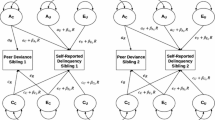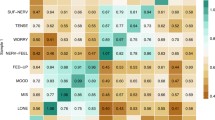Abstract
The present twin study combined self- and peer assessments of twins’ general homophobia targeting gay men in order to replicate previous behavior genetic findings across different rater perspectives and to disentangle self-rater-specific variance from common variance in self- and peer-reported homophobia (i.e., rater-consistent variance). We hypothesized rater-consistent variance in homophobia to be attributable to genetic and nonshared environmental effects, and self-rater-specific variance to be partially accounted for by genetic influences. A sample of 869 twins and 1329 peer raters completed a seven item scale containing cognitive, affective, and discriminatory homophobic tendencies. After correction for age and sex differences, we found most of the genetic contributions (62%) and significant nonshared environmental contributions (16%) to individual differences in self-reports on homophobia to be also reflected in peer-reported homophobia. A significant genetic component, however, was self-report-specific (38%), suggesting that self-assessments alone produce inflated heritability estimates to some degree. Different explanations are discussed.



Similar content being viewed by others
Notes
The calculation of standard errors in the context of twin data ignoring the dependence of data within twin pairs may lead to estimates that are either too large or too small (depending on the underlying twin correlation structure) and, hence, to p-values that are lower or larger than warranted. This dependence of twin siblings might distort the results based on the combined sample. Therefore, we additionally ran preliminary analyses based on two subsamples, in which one twin of a pair was randomly assigned. Since the results were not different to those based on the combined sample, we only reported the results for the combined sample and treated each twin as independent individuals.
Although Verweij and colleagues did not specify the homosexual’s sex, it has been previously discussed that people primarily associate gay men when thinking about homosexuality and homosexuals (e.g., Kite and Whitley 1996).
References
Altemeyer B, Hunsberger B (1992) Authoritarianism, religious fundamentalism, quest, and prejudice. Int J Psychol Relig 2(2):113–133
Arbuckle JL (2012) IBM SPSS Amos 21 User’s Guide. Amos Dev Corp
Balsam KF, Rothblum ED, Beauchaine TP (2005) Victimization over the life span: A comparison of lesbian, gay, bisexual, and heterosexual siblings. J Consult Clin Psych 73(3):477–487
Boyer P, Bergstrom B (2011) Threat-detection in child development: an evolutionary perspective. Neurosci Biobehav Rev 35(4):1034–1041
Brewer PR (2003) The shifting foundations of public opinion about gay rights. J Polit 65(4):1208–1220
Browne MW, Cudeck R (1993) Alternative ways of assessing model fit. In: Bollen KA, Long JS (eds) Testing structural equation models. Sage, Newbury Park, pp 136–162
Burn SM (2000) Heterosexuals’ use of “fag” and “queer” to deride one another: A contributor to heterosexism and stigma. J Homosexual 40(2):1–11
Eaves L, Hatemi PK (2008) Transmission of attitudes toward abortion and gay rights: Effects of genes, social learning and mate selection. Behav Genet 38:247–256
Eaves L, Heath A, Martin N, Maes H, Neale M, Kendler K, Kirk K, Corey L (1999) Comparing the biological and cultural inheritance of personality and social attitudes in the Virginia 30,000 study of twins and their relatives. Twin Res 2(2):62–80
Goodnight BL, Cook SL, Parrott DJ, Peterson JL (2014) Effects of masculinity, authoritarianism, and prejudice on antigay aggression: A path analysis of gender-role enforcement. Psychol Men Masculin 15(4):437–444
Herek GM (2015) Beyond ‘homophobia’: Thinking more clearly about stigma, prejudice, and sexual orientation. Am J Orthopsychiatr 85(5):S29–S37
Hodson G, Busseri MA (2012) Bright minds and dark attitudes: Lower cognitive ability predicts greater prejudice through right-wing ideology and low intergroup contact. Psychol Sci 23(2):187–195
Hu L, Bentler PM (1999) Cutoff criteria for fit indexes in covariance structure analysis: Conventional criteria versus new alternatives. Struct Equ Model 6(1):1–55
Inbar Y, Pizarro DA, Knobe J, Bloom P (2009) Disgust sensitivity predicts intuitive disapproval of gays. Emotion 9(3):435–439
Johnson MK, Rowatt WC, Barnard-Brak LM, Patock-Peckham JA, LaBouff JP, Carlisle RD (2011) A mediational analysis of the role of right-wing authoritarianism and religious fundamentalism in the religiosity-prejudice link. Pers Indiv Differ 50(6):851–856
Kandler C, Riemann R, Spinath FM, Angleitner A (2010) Sources of variance in personality facets: A multiple-rater twin study of self-peer, peer-peer, and self-self (dis)agreement. J Pers 78(5):1565–1594
Kandler C, Bell E, Riemann R (2016) The Structure and sources of right-wing authoritarianism and social dominance orientation. Eur J Pers 30(4):406–420
Katz-Wise SL, Hyde JS (2012) Victimization experiences of lesbian, gay, and bisexual individuals: a meta-analysis. J Sex Res 49(2–3):142–167
Kite ME, Whitley BE (1996) Sex differences in attitudes towards homosexual persons, behaviors, and civil rights: a meta-analysis. Pers Soc Psychol B 22(4):336–353
Klassen AD, Williams CJ, Levitt EE (1989) Sex and morality in the US: An empirical enquiry under the auspices of the Kinsey Institute, 1st edn. Wesleyan University Press, Middletown
Konstabel K, Aavik T, Allik J (2006) Social desirability and consensual validity of personality traits. Eur J Pers 20(7):549–566
Kosciw JG, Greytak EA, Diaz EM (2009) Who, what, where, when, and why: Demographic and ecological factors contributing to hostile school climate for lesbian, gay, bisexual, and transgender youth. J Youth Adolesc 38(7):976–988
Little RJA, Rubin DB (2002) Statistical analysis with missing data. Wiley, New York
McGue M, Bouchard TJ Jr (1984) Adjustment of twin data for the effects of age and sex. Behav Genet 14(4):325–343
Nagoshi JL, Adams KA, Terrell HK, Hill ED, Brzuzy S, Nagoshi CT (2008) Gender differences in correlates of homophobia and transphobia. Sex Roles 59(7–8):521–531
Onraet E, Van Hiel A, Dhont K, Pattyn S (2013) Internal and external threat in relationship with right-wing attitudes. J Pers 81(3):233–248
Parrott DJ (2009) Aggression toward gay men as gender role enforcement: Effects of male role norms, sexual prejudice, and masculine gender role stress. J Pers 77(4):1137–1166
Paulhus DL, Vazire S (2007) The self-report method. In: Robins RW, Fraley RC, Krueger RF (eds) The handbook of research methods in personality. The Guilford Press, New York, pp 224–239
Podsakoff PM, MacKenzie SB, Lee J-Y, Podsakoff NP (2003) Common method biases in behavioral research: a critical review of the literature and recommended remedies. J Appl Psychol 88(5):879–903
Riemann R, Kandler C (2010) Construct validation using multitrait-multimethod-twin data: THE case of a general factor of personality. Eur J Pers 24:258–277
Steffens MC, Wagner C (2004) Attitudes toward lesbians, gay men, bisexual women, and bisexual men in Germany. J Sex Res 41(2):137–149
Steiger JH (1990) Structural model evaluation and modification: An interval estimation approach. Multivar Behav Res 25(2):173–180
Stößel K, Kämpfe N, Riemann R (2006) The Jena twin registry and the Jena twin study of social attitudes (JeTSSA). Twin Res Hum Genet 9(6):783–786
United States Department of Justice, Federal Bureau of Investigation (2016) Hate Crime Statistics, 2015. https://ucr.fbi.gov/hate-crime/2015/tables-and-data-declarations/4tabledatadecpdf
Verhulst B, Eaves LJ, Hatemi PK (2012) Correlation not causation: the relationship between personality traits and political ideologies. Am J Polit Sci 56(1):34–51
Verweij KJH, Shekar SN, Zietsch BP, Eaves LJ, Bailey M, Boomsma DI, Martin NG (2008) Genetic and environmental influences on individual differences in attitudes toward homosexuality: an Australian twin study. Behav Genet 38(3):257–265
Warriner K, Nagoshi CT, Nagoshi JL (2013) Correlates of homophobia, transphobia, and internalized homophobia in gay or lesbian and heterosexual samples. J Homosex 60(9):1297–1314
Whitley BE (2009) Religiosity and attitudes toward lesbians and gay men: a meta-analysis. Int J Psychol Relig 19(1):21–38
Zapko-Willmes A, Kandler C (2016a) Genetic hypotheses of homophobia. In: Shackelford TK, Weekes-Shackelford V (eds) Encyclopedia of evolutionary psychological science. Springer, New York
Zapko-Willmes A, Kandler C (2016b) Social hypotheses of homophobia. In: Shackelford TK, Weekes-Shackelford V (eds) Encyclopedia of evolutionary psychological science. Springer, New York
Zeichner A, Reidy DE (2009) Are homophobic men attracted to or repulsed by homosexual men? Effects of gay male erotica on anger, fear, happiness, and disgust. Psychol Men Masculin 10(3):231–236
Funding
This study was supported by the Deutsche Forschungsgemeinschaft (DFG; Grant Number KA 4088/2-1).
Author information
Authors and Affiliations
Corresponding author
Ethics declarations
Conflict of interest
Alexandra Zapko-Willmes and Christian Kandler declare that they have no conflict of interest.
Ethical approval
All procedures performed in studies involving human participants were in accordance with the ethical standards of the institutional and/or national research committee and with the 1964 Helsinki Declaration and its later amendments or comparable ethical standards.
Informed consent
Informed consent was obtained from all individual participants included in the study.
Additional information
Edited by Wendy Slutske.
Rights and permissions
About this article
Cite this article
Zapko-Willmes, A., Kandler, C. Genetic Variance in Homophobia: Evidence from Self- and Peer Reports. Behav Genet 48, 34–43 (2018). https://doi.org/10.1007/s10519-017-9884-9
Received:
Accepted:
Published:
Issue Date:
DOI: https://doi.org/10.1007/s10519-017-9884-9




